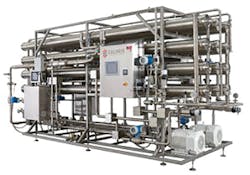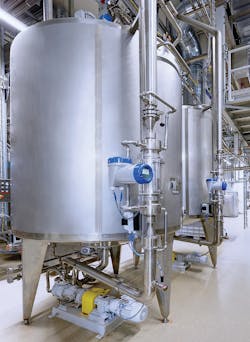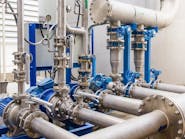Examples show getting the job done isn’t 'one size fits all'
In the food and beverage industry, water is connected to everything from sustainability goals to operational efficiency targets. New technologies, when chosen appropriately, not only make these sustainability goals more attainable but also help to improve cost savings and product quality. For example, without a reliable stream of properly purified water, contaminants in ingredient water can affect product consistency, taste, odor and clarity. Without proper wastewater treatment, plants can face regulatory headaches in the forms of fines and lost profits resulting from public relations nightmares.
Indeed, for today’s food and beverage facilities, having the tools necessary to use water efficiently is a top priority. Here are a few examples getting the job done in factories and plants all over the world.
Milking It
A milk powder production facility located in a water-stressed region had the goal to minimize its environmental footprint as well as conserve water resources. The customer wanted to recover the vapor condensate discharging from the evaporation process systems (called cow water) and process it to a quality suitable as Category I for use in potable water applications.
Two reverse osmosis (RO) polisher systems from Caloris capable of processing cow water generated from the evaporation process systems at a permeate rate of 100 gallons per minute for up to 20 continuous hours each day were used. Because the facility relies entirely on the Category I water to support its operations, facility staff elected to go with completely redundant RO systems. This provides an adequate safety factor and allows for maintenance on the systems.
Prior to entering the RO systems, the energy from the hot condensate is recovered by pre-heating the whole milk prior to cream separation. After this step, the cool cow condensate enters the RO system. The RO discharge concentrate (at 90 percent recovery) is safely diverted to the drain, while the RO permeate is disinfected by the inline PMO (Pasteurized Milk Ordinance) ultraviolet (UV) device and then sent to the potable permeate silos.
Automated clean-in-place (CIP; inclusive of chemical dosing, heating and cooling) is independently initiated for each RO system at the conclusion of that RO system’s 20-hour production run. Both RO systems are also capable of using well water as a feed source.
The two RO systems were delivered as a single, pre-assembled skid including pre-piped RO element housings, pumps and heat exchangers. This helped reduce the cost of the installation as well as the time to complete it. Today, the project produces more than 144,000 gallons of potable water for the facility daily.
The (Chocolate) Icing on the Cake
Typical food and beverage processes include tracking inventory (of the feedstock or end product), batching, and blending operations, where precise knowledge of solids, powders, or liquids level is a must to guarantee quality.
In a chocolate plant, tracking inventory begins with measuring the filling of feedstock tanks. Trucks roll in and offload raw material, like milk and cocoa. Tanks are periodically filled with solids or liquids and continuously drained. On the other end of the process, operators require an inventory of finished goods. Inventory tracking here enables fiscal tracking of feedstock on one end and saleable goods on the other.
Between the incoming and outgoing inventory tracking is the actual chocolate making process where operators are using reactor tanks for heating, cooling, batching, and blending. For some level measurement tools, tracking the steam used for heating, cooling, and blending operations can present a challenge because of buildup of vapors or dust.
A wide range of level measurement technologies can be used in the food and beverage industry, including manual, contact, and non-contact methods. While each measurement type has its pros and cons, new non-contact frequency-modulated continuous wave (FMCW) radar technology eliminates many of the issues experienced with other technologies, including moving parts and their associated maintenance issues, unreliability of measurements caused by buildup of material, and the effect of process connections. In addition, there is no intrusion into the process, so there is no risk of introducing any metal sensor parts into the process.
KROHNE recently developed an FMCW level transmitter specifically designed to meet food and beverage requirements. This model has 3-A certification and tri-clamp connectors, hazardous area certifications, and meets material specifications for food and beverage industries. With a form factor especially designed to accommodate process connections, the device is adaptable to process vessels, using tri-clamp adapters that are common in food and beverage applications. The small antenna design means it can be used with shorter tanks.
The technology has been used successfully at several chocolate-making operations to improve stock management through automated level measurement. The technology provides reliable and accurate readings despite viscous, sticky liquid and moving product surface. It gives operators continuous and precise readings of the liquid chocolate level right up to the process connection.
The flush-mounted antenna does not intrude into the tank, which avoids deposits and keeps maintenance costs low. Thanks to the small beam angle, the radar can measure agitated product surfaces with an accuracy of ±2 mm (±0.08 inches). The measured values are automatically forwarded to the control room.
The device continuously measures the level of the liquid chocolate and automatically transmits the values to the control room. The measuring technology optimizes the supply inventory and reduces maintenance and production costs at both plants. In a multi-tank plant, the device replenishes the tank whenever the chocolate level falls below a certain threshold.
Wine of the Times
For many wineries, the standard rinsing and cleaning processes produce high-strength wastewater — effectively, diluted wine. The resulting effluent has high levels of biochemical oxygen demand (BOD), a major strain for traditional municipal treatment plants. Cambrian Innovation‘s EcoVolt membrane bioreactor (MBR) takes a novel approach to a traditional aerobic digester, with separate unit processes for dynamic modularity. The aerobic treatment process takes place in dedicated state-of-the-art aeration tanks, while the ultrafiltration membrane modules are housed in filtration tanks to separate any solids and produce Title-22 quality effluent.
In 2018, Napa Valley’s Rombauer Vineyards installed the EcoVolt® treatment system. The two-step treatment process includes bulk BOD removal through one anaerobic EcoVolt Reactor and final polishing through one aerobic EcoVolt MBR. The system is powered and controlled by a C3 (Command, Control, Communications) Hub, Cambrian’s centralized operations station that distributes power through the rest of the system and allows for simplified installation, automated operations, and remote monitoring. The solution treats 100 percent of the winery’s wastewater and can easily expand to accommodate any increases in wine production.
The two-step EcoVolt Solution consistently removes >99.9 percent of the BOD in the winery’s wastewater. Even through variable flows and loads of the typical crush season, the anaerobic EcoVolt Reactor averages a 94 percent removal efficiency in the first step, remarkable for anaerobic wastewater treatment. In the second step, the aerobic EcoVolt MBR polishes the final 6 percent of the BOD in the stream. The full EcoVolt Solution’s final, highly-treated effluent is then ready for low-impact and low-cost discharge to the local municipality.
The two tanks integrate seamlessly to make up a suite of unit sizes that can precisely map to the specific flow and load requirements of any facility and eliminate the cost and operational inefficiencies typically incurred by standardized membrane bioreactor packages. IWW
About the Author: Alanna Maya is assistant editor of WaterWorld and Industrial WaterWorld magazines. Email her at [email protected].





